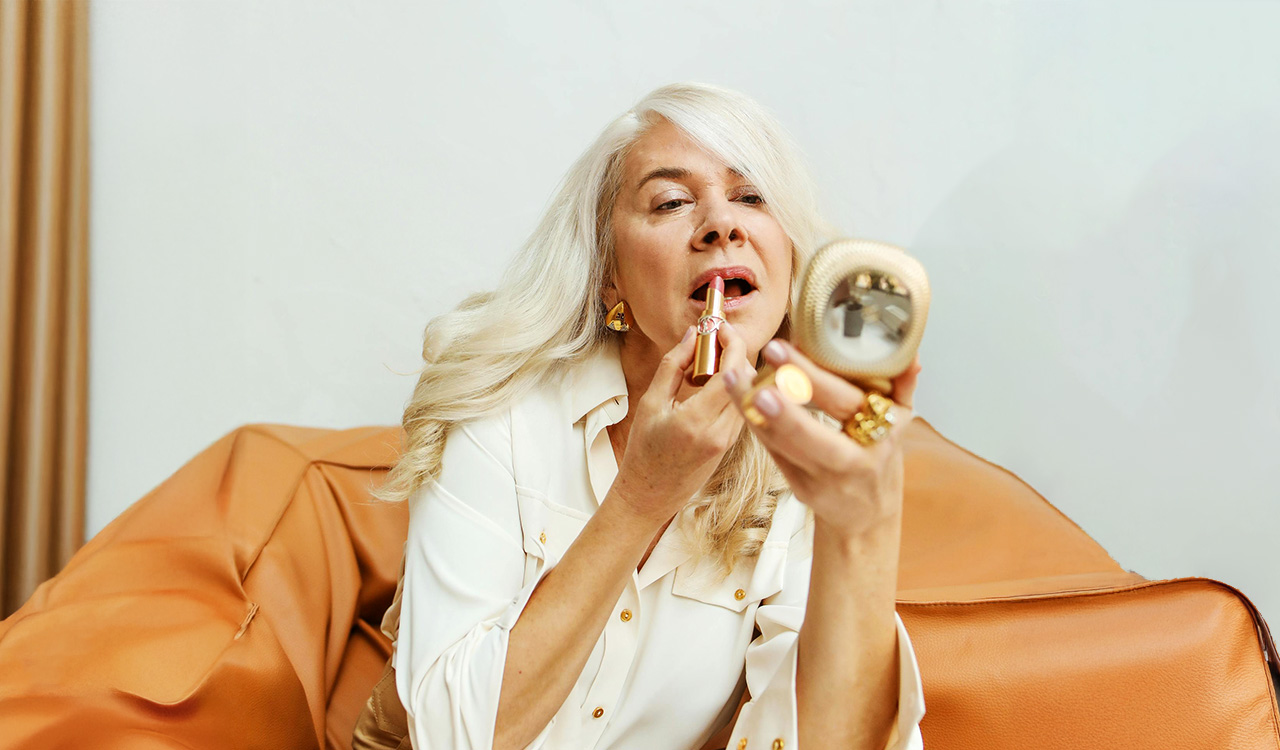Brand executives seem to have an instinctive obsession with channeling marketing strategies and budgets toward winning over the Gen Z demographic. This is nothing new; next gens are always more attractive to marketers projecting youth and exuberance and they can often change the way a brand is perceived.
The Emily in Paris star Philippine Leroy-Beaulieu (1.1 million followers on Instagram), the 61-year-old French actress who plays Emily’s boss made a front-row appearance at the Saint Laurent show at Paris Fashion Week. She is celebrated as an authentic representation of timeless elegance. For luxury brands, these role models serve as a silver lining — a reminder that mature celebrities can enhance a brand’s relevance and prestige.
The latest dramatic Jaguar rebranding identity (including the iconic logo redesign) campaign, ‘Copy Nothing’ is no exception. It redirects “focus on Gen Z, emphasizing diversity, creativity and bold expression.” There is no denying Gen Z’s importance as a driver of future growth. Bain & Co estimates that by 2030, this demographic will contribute to 25–30 percent of luxury market purchases. Yes but, there’s the reality of who’s actually got deep pockets right noiw. The power of the Silver Generation’s spending power is often overlooked.
The cooling of the luxury market is a stark reminder that it will be increasingly difficult for prestige brands to drive growth from younger generations alone. The squeezing of Gen Z’s disposable incomes coupled with an uncertain economic outlook is changing spending patterns. Millennials are in a high acquisition life stage with young families.
Demographic Shifts
The world is getting older which is “an irreversible global trend,” according to the United Nations. As reported by McKinsey & Co., the share of the U.S. population aged 50+ will reach 37 percent in 2025, growing to 42 percent by 2050. This trend is even more pronounced in China, where over half the population will be aged 50 or older by 2050 and in Japan where 36 percent of the population will be aged 65+.
Silver Spenders
The silver generation population has an enviable spending power that accounts for an increasing share of consumption. Approximately 73 percent of all wealth in the U.S. is accounted for by the over-55s. The silver economy is reflected in market data across numerous consumer categories. For instance, the State of Fashion 2025 report by McKinsey & Co. and Business of Fashion reveals that the silver generation accounts for a larger share of total fashion spending than younger consumers. In 2023, those aged 59 and over contributed 37 percent of U.S. retail apparel spending, compared to 23 percent for millennials.
Myths Debunked
Brand executives with a youth bias risk missing out on significant growth opportunities if they fail to challenge common misconceptions about the evolving consumer and lifestyle trends of the silver generation population. First, the idea that older adults are not significant consumers is a myth. In 2023, per capita spending on clothing among those aged 59 and older in the U.S. was 21 percent higher than that of millennials and Gen Z combined.
Second, the stereotype of mature adults as laggards is outdated. The silver population embraces healthier lifestyles, with individuals aged 55+ comprising approximately 23 percent of U.S. gym memberships. They also prioritize physical appearance and mental well-being. In Great Britain, France, and Spain, women over 55 account for nearly half of all beauty product sales in a confluence of wants and needs.
Finally, the assumption that digital engagement is limited to younger generations doesn’t hold up. While younger cohorts dominate social media, silver surfers are catching up. In the UK, individuals over 70 spend more time online than any other age group except Gen Z. Surprisingly, the Entertainment Software Association reports that 29 percent of U.S. gamers are aged 50 and older – an increase from 17 percent in 2004.
Silver Generation Strategy
The silver generation is far from homogeneous and should not be defined solely by age but rather by their lifestyles, attitudes and values. Brands that craft a silver strategy tailored to specific needs and aspirations can significantly impact their bottom line. The beauty business is ahead of the curve. For example, L’Oréal Paris’ Age Perfect Golden Age Rosy-Oil Serum is designed specifically for mature skin. The launch was supported by silver influencers, which, according to Gabriella Ostrenius, Nordic Social Brand Lead at L’Oréal Paris, aimed “to reach a growing, tech-savvy mature audience while delivering a refreshingly positive message about personal care.”
Optics are crucial and role models are influencers. Emily in Paris star Philippine Leroy-Beaulieu (1.1 million followers on Instagram), the 61-year-old French actress who plays Emily’s boss, made a front-row appearance at the Saint Laurent show at Paris Fashion Week. She is celebrated as an authentic representation of timeless elegance, joining other leading high-profile actresses including Helen Mirren and Isabella Rossellini. For luxury brands, these role models serve as a silver lining – a reminder that mature celebrities can enhance a brand’s relevance and prestige.
Intergenerational Appeal
Brands that have built brand equity around ‘youth culture’ typically hesitate to embrace silver marketing. The risk of diluting their ‘cool’ image is too high. But that’s a short-sighted strategy. Attention to detail in execution can make a meaningful difference to create intergenerational appeal. For example, the new Gucci Blondie bag presented on the Cruise 2025 runway is promoted by the 79-year-old music and beauty icon Debbie Harry. Her charisma not only resonates with mature audiences but also serves as an inspiring role model for younger generations.
Intergenerational Diversity
A company’s internal culture is a key factor in leveraging the market potential of the silver demographic. At L’Oréal, 15 percent of the global workforce is over 50 years old, and its ‘For All Generations’ program, launched in 2022, actively promotes intergenerational diversity. This initiative fosters greater diversity in the decision-making process at all levels throughout the organization.
Intergenerational mentoring has been recognized as critical to the transfer of knowledge within the luxury fashion industry. Bottega Venita’s Accademia Labor et Ingenium which opened in 2023 is according to Leo Rongone, Bottega Veneta CEO, “a key strategic pillar to preserve Bottega Veneta’s unique savoir-faire”. The craft school allows master artisans to pass down their know-how, skills and experience to a new generation of artisans.
A Delicate Balance
The challenge for brand executives is to balance their silver strategies to capitalize on incremental growth opportunities without alienating existing customers. Burberry’s new CEO, Joshua Schulman, has recognized the importance of re-engaging high-spending consumers who invest in quality products. It is a refresh of the brand’s past strategy to over-prioritize younger, trend-focused audiences who may or may not have purchased the products.
Maintaining that life stage balance is a tightrope. The social media backlash against Jaguar’s current rebranding campaign is a case in point. Jaguar’s managing director, Rawdon Glover, noted, “We don’t want to necessarily leave all of our customers behind. But we do need to attract a new customer base.” The jury’s out on whether Jaguar risks sidelining the brand’s core customer base in pursuit of broader appeal. The new logo attempts to express modernity and minimalism for a legacy brand. It remains to be seen if Jaguar will successfully strike this balance.





